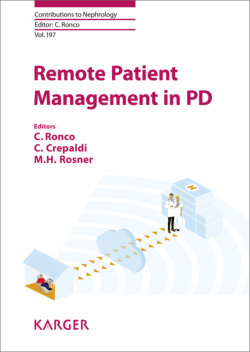Читать книгу Remote Patient Management in Peritoneal Dialysis - Группа авторов - Страница 23
На сайте Литреса книга снята с продажи.
Origin of APD
ОглавлениеThe first application of PD was in 1959 by Morton Maxwell. He set up a rudimental system to deliver fluids into abdomen, which can be considered the forerunner of the modern CAPD. The system consisted of two 1 L bottles, filled with warm dialysis solutions, connected through a Y tube, to the catheter. The bottles were hung above the bed, to allow the dialysis fluids to flow by gravity into the abdomen. After 1 h dwell time, the bottles were lowered into the floor and used for drainage. This procedure was repeated for 12–36 h and was performed manually. The maneuver of changing bottles requires multiple disconnections of the system, representing the major risk of touch contamination. To overcome this complication, containers of 10 L were subsequently used both for load and drain phases, significantly reducing the number of connections.
Fig. 1. Evolution of PD cyclers from origin to today. PD, peritoneal dialysis; APD, automated PD; IPD, intermittent PD; CCPD, continuous cyclic PD.
In 1962 in Seattle, Boen et al. [3, 4] conceived the first cycler able to deliver and drain fluids into and from the abdomen, semi-automatically. Dialysis fluids were prepared in the University pharmacy and stored in 40 L containers and periodically shipped to patient’s home. The fluids were pumped into an elevated reservoir, filled up to 2 L, and from there, moved to peritoneal cavity simply by gravity. Inflow, dwell, and outflow were regulated by a timer, which controlled clamps. Therapy was intermittent, performed once a week, over 20–22 h/session. The advantage of this semi-automatic technique, compared to the manual paired bottles, was the reduction of the number of connections and therefore the risk of touch contamination. Subsequently, smaller plastic containers (10 L) were connected in series for a closed-circuit PD.
In 1966, Lasker designed the first “PD cycler.” It featured 4 bottles of dialysis solution to obtain a reservoir of 8 L, connected to pre-sterilized disposable tubings and bags. This concept of semi-automatic machine was then applied to many other cyclers with few variations. In principle, a pump was moving fluid to fill a 2 L bag suspended above the patient and then inflow and outflow into and from the abdomen was operated by gravity.
The next step in automatization was to design a machine able to produce sterile dialysate directly at patient’s home, avoiding transport of large amount of fluids. At the end of 1960, Tenckhoff created a system able to purify cold tap water by reverse osmosis to be mixed with a liquid concentrate of glucose and electrolytes. The automatic cycler allowed the production of large amounts of safe and sterile dialysate, but it was bulky and costly. In 1970s, semi-automatic machines were mostly used in Europe, while automatic equipment was preferred in USA where 10 L tanks were not available.
Both semi-automatic and automatic machines began the era of APD and were mostly used in the hospital setting for intermittent PD, also defined nightly intermittent PD. With the advent of CAPD in the 1970s, the use of the machine was partially abandoned. CAPD was easier than APD and patients could manage treatment by themselves at home, without costly and cumbersome machinery. Moreover, CAPD was preferred because of its better results in terms of treatment adequacy [3, 4]. This was the state of art until the 1980s when new generation cycler became available, spurring a renewed interest in APD.
